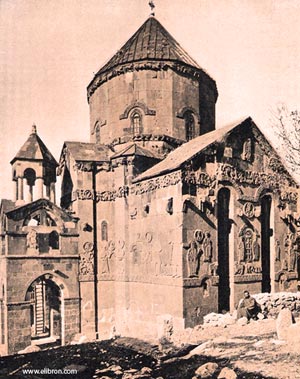Ministry Spokesperson Comments on the Reopening of Akhtamar Church
28 March, 2007The Turkish government, through its Ministry of Culture, has supervised the expert renovation of the Church of Holy Cross on Akhtamar Island in Van, in Eastern Turkey. This renovation includes the restoration of frescoes inside the church and the relief work on the exterior. The Ministry of Culture will formally open the church, which will now be recognized as a museum, on March 29, 2007.
 The Armenian government will send a delegation headed by the Deputy Minister of Culture, himself a preservation expert, accompanied by several historians and members of the arts community, in recognition of the gesture by Turkey. Armenia would encourage Turkey to engage in a substantive process toward open borders and normal relations and not be satisfied with isolated symbols and gestures, however.
The Armenian government will send a delegation headed by the Deputy Minister of Culture, himself a preservation expert, accompanied by several historians and members of the arts community, in recognition of the gesture by Turkey. Armenia would encourage Turkey to engage in a substantive process toward open borders and normal relations and not be satisfied with isolated symbols and gestures, however.
Van, a city of 300,000 today, is 396 km (250 miles) from Yerevan. The region of Van, where Akhtamar is located, was one of the most densely Armenian populated regions of Eastern Anatolia, which for six centuries, formed the eastern border of the Ottoman Empire. The Armenians of the region were killed or deported in the early 20th century. The policy of genocide included destruction of a way of life as well as a nation’s holy places and monuments. This church, as well as the people who worshipped there, were destroyed or abandoned.
The small island of Akhtamar, on which the 10th century Armenian King Gagik built his royal residence, complete with palace, church and extensive gardens is two miles from the shore. The exterior of Gagik's magnificent palace church is carved with friezes representing a wide variety of biblical scenes and secular, historic motifs. The church is recognized as one of the earliest and finest examples of Romanesque architecture in the Byzantine world and in medieval Christendom generally, a precursor of the great Romanesque churches of the Mediterranean.
Ministry spokesperson Vladimir Karapetian had the following comments concerning the reopening of the church.
We are pleased that the Armenian Church of Holy Cross on Akhtamar island, a jewel of world architecture, has been beautifully restored and renovated, albeit without a cross, and as a museum.
This is a positive move and holds the potential of a reversal of the policy of negligence and destruction.
We hope the same kind approach will extend to cover the nearly-collapsed churches of Ani, Mush, Tegor, and a dozen other priceless examples of Armenian medieval architecture, which have been abandoned at best, or more often, intentionally vandalized, simply because of their Armenian identity.
Unfortunately, this opening was not transformed to a new opportunity in Armenia- Turkish relations, because the Turkish government has not found it expedient to do so. Instead, it will remain a formal ceremony, in which a small official delegation will participate.
The border was not opened, even for one day, to allow our peoples to share this singular, historic event together. Instead, those from Armenia wishing to attend will be forced to travel, through a third country, two days to get there and back. This could have been a four-hour car ride across the border enjoyed by many.
Turkey’s announcements about the opening of this renovated church do not include the word ‘Armenian’ anywhere. Names of kings and regions from medieval times are evoked, but no mention is made of its Armenian and Apostolic belonging. This is an evasion of the Turkish government’s responsibility not only to history and memory, but to its own Armenian minority.
Ironically, at the same time, many are heralding this renovation as a step forward in Armenia-Turkey relations. This is because the Turkish authorities need to demonstrate something positive in that direction. It is no coincidence that this opening is being held just as the US Congress is considering a resolution on affirming the US record on the Armenian Genocide.
Even before the opening, pictures of the renovated church are being distributed in Washington as a sign of goodwill from Turks towards Armenians, and therefore obviating the need for third country pressure on Turkey.
Armenia and Armenians wish for substantive progress with Turkey regarding our painful past and a potential of a shared future as neighbors. Armenia and Armenians do not want to be played in a never-ending process of gestures that do not intend to make real inroads in reconciliation, and instead are simply public relations moves.
Armenia asks that the international community encourage Turkey to engage in a substantive process toward open borders and normal relations and not be satisfied with isolated symbols and gestures.”

